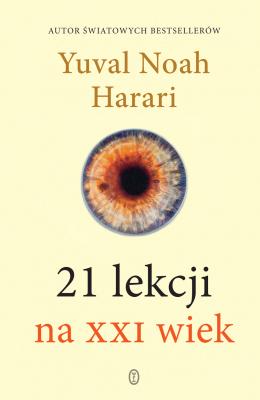21 lekcji na XXI wiek. Yuval Noah Harari
Читать онлайн.| Название | 21 lekcji na XXI wiek |
|---|---|
| Автор произведения | Yuval Noah Harari |
| Жанр | Документальная литература |
| Серия | |
| Издательство | Документальная литература |
| Год выпуска | 0 |
| isbn | 9788308067123 |
13
Na przykład: sztuczna inteligencja jest lepsza od ludzi w pilotowaniu, a zwłaszcza w symulacji lotów bojowych – zob. N. Ernest et al., Genetic Fuzzy based Artificial Intelligence for Unmanned Combat Aerial Vehicle Control in Simulated Air Combat Missions, „Journal of Defense Management” 2016, nr 6(1), s. 1–7. Inne przykłady: inteligentne systemy indywidualnego nauczania – K. VanLehn, The Relative Effectiveness of Human Tutoring, Intelligent Tutoring Systems, and Other Tutoring Systems, „Educational Psychologist” 2011, nr 46(4), s. 197–221; handel oparty na algorytmach – G. Nuti et al., Algorithmic Trading, „Computer” 2011, nr 44(11), s. 61–69; planowanie finansów, zarządzanie portfelem itd. – A. Baharammirzaee, A Comparative Survey of Artificial Intelligence Applications in Finance. Artificial Neural Networks, Expert System and Hybrid Intelligent Systems, „Neural Computing and Applications” 2010, nr 19(8), s. 1165–1195; analiza złożonych danych w systemach medycznych oraz w stawianiu diagnozy i określaniu leczenia – M. Glass Zauderer et al., Piloting IBM Watson Oncology within Memorial Sloan Kettering’s Regional Network, „Journal of Clinical Oncology” 2014, nr 32(150), s. e17653; tworzenie oryginalnych tekstów w języku naturalnym z ogromnych ilości danych – J.-S. Vayre et al., Communication Mediated through Natural Language Generation in Big Data Environments. The Case of Nomao, „Journal of Computer and Communication” 2017, nr 5, s. 125–148; rozpoznawanie twarzy – F. Schroff, D. Kalenichenko, J. Philbin, FaceNet. A Unified Embedding for Face Recognition and Clustering, „IEEE Conference on Computer Vision and Pattern Recognition (CVPR)” 2015, s. 815–823; oraz prowadzenie samochodu – C. Premebida, A Lidar and Vision-based Approach for Pedestrian and Vehicle Detection and Tracking, [w:] 2007 IEEE Intelligent Transportation Systems Conference, 2007.
14
D. Kahneman, Pułapki myślenia. O myśleniu szybkim i wolnym, przeł. P. Szymczak, Poznań [cop.] 2012; D. Ariely, Potęga irracjonalności. Ukryte siły, które wpływają na nasze decyzje, przeł. T. Grzegorzewska, Wrocław 2009; B.D. Ripley, Pattern Recognition and Neural Networks, Cambridge 2007; Ch.M. Bishop, Pattern Recognition and Machine Learning, New York 2007.
15
S. Azimi et al., Vehicular Networks for Collision Avoidance at Intersections, „SAE International Journal of Passenger Cars – Mechanical Systems” 2011, nr 4, s. 406–416; S. Kumar et al., CarSpeak. A Content-Centric Network for Autonomous Driving, „SIGCOM Computer Communication Review” 2012, nr 42, s. 259–270; M.L. Sichitiu, M. Kihl, Inter-Vehicle Communication Systems. A Survey, „IEEE Communications Surveys & Tutorials” 2008, s. 10; M. Gerla, E.-K. Lee, G. Pau, Internet of Vehicles. From Intelligent Grid to Autonomous Cars and Vehicular Clouds, „2014 IEEE World Forum on Internet of Things (WF-IoT)” 2014, s. 241–246.
16
D.D. Luxton et al., mHealth for Mental Health. Integrating Smartphone Technology in Behavioural Healthcare, „Professional Psychology: Research and Practice” 2011, nr 42(6), s. 505–512; A.S.M. Mosa, I. Yoo, L. Sheets, A Systematic Review of Healthcare Application for Smartphones, „BMC Medical Informatics and Decision Making” 2012, nr 12(1), s. 67; K.F.B. Payne, H. Wharrad, K. Watts, Smartphone and Medical Related App Use among Medical Students and Junior Doctors in the United Kingdom (UK). A Regional Survey, „BMC Medical Informatics and Decision Making” 2012, nr 12(1), s. 121; S.K. Vashist, E.M. Schneider, J.H.T. Loung, Commercial Smartphone-Based Devices and Smart Applications for Personalised Healthcare Monitoring and Management, „Diagnostics” 2014, nr 4(3), s. 104–128; M.N. Kamel Bouls et al., How Smartphones Are Changing the Face of Mobile and Participatory Healthcare. An Overview, with Example from eCAALYX, „BioMedical Engineering OnLine” 2011, nr 10(24), https://doi.org/10.1186/1475-925X-10-24 (dostęp: 30 lipca 2017); P.J.F. White, B.W. Podaima, M.R. Friesen, Algorithms for Smartphone and Tablet Image Analysis for Healthcare Applications, „IEEE Access” 2014, nr 2, s. 831–840.
17
World Health Organization [Światowa Organizacja Zdrowia], Global status report on road safety 2015 (2016); idem, Global Health Estimates 2015. Deaths by Cause, Age, Sex, by Country and by Region, 2000–2015, Geneva 2016, http://www.who.int/healthinfo/global_burden_disease/estimates/en/index1.html (dostęp: 6 września 2017).
18
Na temat badania przyczyn wypadków samochodowych w Stanach Zjednoczonych zob. D.J. Fagnant, K. Kockelman, Preparing a Nation for Autonomous Vehicles. Opportunities, Barriers and Policy Recommendations, „Transportation Research Part A: Policy and Practice” 2015, nr 77, s. 167–181; na temat ogólnoświatowego badania zob. np. OECD/ITF, Road Safety Annual Report 2016, Paris 2016, http://dx.doi.org/10.1787/irtad-2016-en.
19
K.D. Kusano, H.C. Gabler, Safety Benefits of Forward Collision Warning, Brake Assist, and Autonomous Braking Systems in Rear-End Collisions, „IEEE Transactions on Intelligent Transportation Systems” 2012, nr 13(4), s. 1546–1555; J.M. Anderson et al., Autonomous Vehicle Technology. A Guide for Policymakers, Santa Monica 2014, zwł. s. 13–
1
Zob. np. przemówienie inauguracyjne George’a W. Busha z 2005 roku, w którym amerykański prezydent powiedział: „Wydarzenia, których jesteśmy świadkami, i zdrowy rozsądek prowadzą nas do jednego wniosku: przetrwanie wolności w naszym kraju coraz bardziej zależy od powodzenia wolności w innych krajach. Największą nadzieją na pokój w naszym świecie jest rozszerzanie wolności na całym świecie”.
2
W. Neikirk, D.S. Cloud,
3
E. Bradner,
